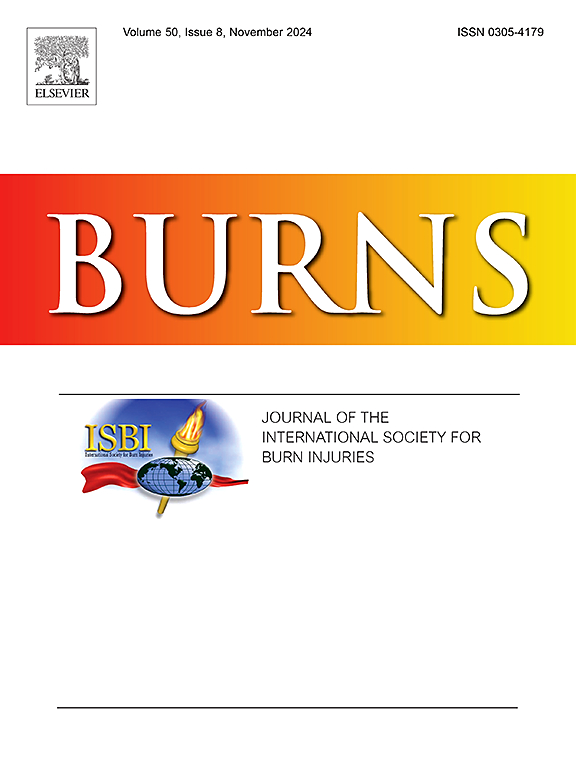在资源有限的情况下,异体输血对烧伤死亡率的影响
IF 3.2
3区 医学
Q2 CRITICAL CARE MEDICINE
引用次数: 0
摘要
全世界有近900万新发烧伤病例,其中低收入和中等收入国家的烧伤负担不成比例。严重烧伤患者经常需要多次输血;然而,在资源有限且基线贫血患病率高的环境中,缺乏关于烧伤后输血效果的数据。本研究旨在确定输血对烧伤死亡率的影响。方法:我们对2011年至2019年期间出现烧伤的患者进行了回顾性研究,使用了Kamuzu中心医院(KCH)前瞻性收集的烧伤登记数据。我们进行了多变量逻辑回归模型来确定死亡率的预测因子,并考虑了潜在的混杂因素。结果共纳入2359例患者。平均年龄为10岁 ± 14岁,男性优势(58 %)。烧伤的平均体表面积百分比(%TBSA)为17.52 ± 14.46。60% %的烧伤是由烫伤引起的,37% %是由火焰引起的。低于40 % TBSA,我们的模型预测输血者的死亡率更高。然而,在40% % TBSA以上,输血者的预测死亡率降低。结论异源性输血使烧伤患者死亡率提高1.23倍(p <; 0.03)。死亡风险随着年龄和输血单位的增加而增加。本研究强调了为烧伤患者输血制定合适的指导方针和方案的必要性。在资源有限的情况下,更严格的输血策略可能更合适。本文章由计算机程序翻译,如有差异,请以英文原文为准。
The effect of allogeneic blood transfusion on burn mortality in a resource-limited setting
Introduction
There are nearly 9 million new burn cases worldwide, with a disproportional burn burden in low- and middle-income countries. Patients with significant burn injury frequently require multiple blood transfusions; however, there is a paucity of data regarding the effect of allogeneic blood transfusion following burn injury in a resource-limited setting with a high anemia prevalence at baseline. This study aimed to determine the effect of blood transfusion on burn mortality.
Methods
We performed a retrospective review of patients presenting with burns between 2011 and 2019, using prospectively collected burn registry data from Kamuzu Central Hospital (KCH). We performed multivariate logistic regression modeling to identify predictors of mortality, and we considered potential confounders.
Results
A total of 2359 patients were included. Mean age was 10 ± 14 with a male preponderance (58 %). The mean percent total body surface area burned (%TBSA) was 17.52 ± 14.46. 60 % of burns were caused by scald injuries and 37 % by flame. Below 40 % TBSA, our model predicted a higher probability of mortality for those transfused. However, above 40 % TBSA, the predicted probability of mortality is decreased for those transfused.
Conclusions
Allogeneic blood transfusion confers 1.23 (p < 0.03) times higher odds of mortality in burn patients. Mortality risk increased with age and units transfused. This study highlights the need for proper guidelines and protocols for allogeneic blood transfusion in burn patients. A more restrictive blood transfusion strategy may be more appropriate in a resource-limited setting.
求助全文
通过发布文献求助,成功后即可免费获取论文全文。
去求助
来源期刊

Burns
医学-皮肤病学
CiteScore
4.50
自引率
18.50%
发文量
304
审稿时长
72 days
期刊介绍:
Burns aims to foster the exchange of information among all engaged in preventing and treating the effects of burns. The journal focuses on clinical, scientific and social aspects of these injuries and covers the prevention of the injury, the epidemiology of such injuries and all aspects of treatment including development of new techniques and technologies and verification of existing ones. Regular features include clinical and scientific papers, state of the art reviews and descriptions of burn-care in practice.
Topics covered by Burns include: the effects of smoke on man and animals, their tissues and cells; the responses to and treatment of patients and animals with chemical injuries to the skin; the biological and clinical effects of cold injuries; surgical techniques which are, or may be relevant to the treatment of burned patients during the acute or reconstructive phase following injury; well controlled laboratory studies of the effectiveness of anti-microbial agents on infection and new materials on scarring and healing; inflammatory responses to injury, effectiveness of related agents and other compounds used to modify the physiological and cellular responses to the injury; experimental studies of burns and the outcome of burn wound healing; regenerative medicine concerning the skin.
 求助内容:
求助内容: 应助结果提醒方式:
应助结果提醒方式:


